
U.S. Naval Gun Factory Mark 37 - 9x 63 Binocular Of World War II
A historic product exhibited among others in the permanent collection at Company Seven
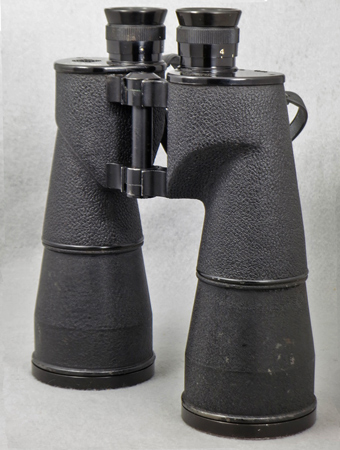
On 23 March 2016 Company Seven acquired a U.S. Navy issued 9x 63 Porro Prism binocular set, specifically a Mark 37 made in 1944. This is our second World War II era U.S. military issue binocular, and is now on permanent exhibit at our showroom museum among our collection of interesting or significant optics. This Mark 37 is displayed near our Bausch & Lomb Mark 28 Mod 0 and U.S. Navy Mark XLIV 7x 50 SARD binocular, also from 1944. In time we will acquire, exhibit, and write about others.
Right: U.S. Naval Gun Factory Mark 37 - 9x 63 binocular. Image courtesy collection of Company Seven (73,613 bytes).
Click on image to see enlarged view (245,393 bytes).
We were pretty excited about finding a Mark 37 binocular in good condition because:
- it was made, and not in great numbers, specifically for use by the Captains and Gun Fire Control Officers of the Battleships and Cruisers in the greatest naval force ever engaged in war: the United States Navy*,
- this typifies that famous Yankee Ingenuity, in this case where production military binoculars were adapted to serve a different purpose,
- the organization that produced these was the Washington Navy Yard optics shop - in itself an interesting story.
- This was developed by The Greatest Generation: men and women who developed a qualitative edge in technology, superior manufacturing capacity, and who made up the forces that with adaptable leadership and some guts too defeated Hitler, Hirohito, and their minions.
- And finally, the tie in to the fictional British Secret Service agent James Bond 007 was too irresistible to overlook.
*at it’s peak in August 1945 the U.S. Navy was operating some 6,768 ships (vessels 100 feet or longer) including: 23 battleships, 28 aircraft carriers, 71 escort carriers, 72 cruisers, more than 288 submarines, 377 destroyers, and thousands of patrol, amphibious, supply, and auxiliary ships. Consider the many other classes included 544 PT Boats, and some 82,266 landing craft built during the war! Every vessel required binoculars.
The excitement needed to be shared with those who have helped to keep Company Seven around for well more than three decades, and so we elected to write about this binocular too.
This article will contain some informational overlap with that content in our previously published article about the U.S. Navy Mark XLIV 7x 50 SARD binocular. We have worked to minimize overlap except where it helps either article stand on it’s own. As new information comes to our attention then we will edit this article as justified.
- Bausch and Lomb Optical Company (B&L), Rochester, New York
- Emil Busch, Rathenow, Germany
- Globe Optical Company, Boston, Massachusetts
- Naval Gun Factory (NGF), Washington Navy Yard, Washington, D.C.
- Spencer Lens Company (American Optical), of Buffalo, New York
- Busch Turlex 10x 45 Mark 1 and Mark 2, General Arrangement No. 45827-O (the suffix is always a letter, here O represents BU.ORD) †
- B&L 7x 50 Mark 2 and Mark 3 (General Arrangement No. 46629-O), aluminum die cast parts †
- B&L Mark 4 5x 30’s Mod 0 and Mod 1 (General Arrangement No. 44775-O) †
- B&L Mark 4 Mod 2 (General Arrangement No. 50191-O), Mod 3 (General Arrangement No. 55341-O) †
- B&L Mark 5 7x 50’s Mod 0 (General Arrangement No. 46801-O) and Mod. 1 (48926-O) †
- NGF Mark 6 10x 45’s Mod 0 (General Arrangement No. 68816-O) and Mod. 1 (68826-O) †
- NGF Mark 7 6x 30’s Mod 0 (General Arrangement No. 66673-O) and Mod. 1 (66674-O) †
- GLOBE 3x, Mark 8 (General Arrangement No. 34730-O), a Galilean optical arrangement †
- NGF Mark 11 6x 30’s, Mod 0 (General Arrangement No. 119683-O), Mod 1 (119683-O), Mod 2 (141890-O), Mod 3 (141890-O) †
- NGF Mark 12 (10x 45’s) Mod 0, Mod 1, and Mod 2 (General Arrangement No. 132869-O) †
- B&L Mark 13 (7x 50’s) Mod 2 (General Arrangement No. 175965-O) and Mod 3 (105900-O) †
- Spencer Mark 13 (7x 50’s) Mod 5 (General Arrangement No. 300872-O) †
- NGF Mark 15 7x 50 (General Arrangement No. 153551-O), experimental)
- NGF Mark 17 4x 25 (General Arrangement No. 153551-O), experimental
- NGF Mark 22 7x 50 (General Arrangement No. 278591-O, with offset wedge attachment †
- NGF Mark 25 10x 70 (experimental, 2 made) and Mod 1 10x70 (244100-O), experimental
- B&L Mark 26 7x 50 (General Arrangement No. 526545-S)
- B&L Mark 27 7x 50 (modified Mark 22)
- B&L Mark 36 10x 50 (General Arrangement No. 526584-S), experimental
- NGF Mark 37 9x 63 (General Arrangement No. 254211-O), modified B&L 7x50s
- B&L Mark 38 7x 50 (General Arrangement No. 30175-C) pressure proof for submarines
- B&L Mark 39 Mod 0 7x 50 (General Arrangement No. 30297-C), a Mark 1 Mod 2 with Reticle
- B&L Mark 39 Mod 1 7x 50 (General Arrangement No. 30326-C, a Mark 28 with Reticle
- Mark 47 B&L 6x 50, pressure proof for submarines
† by 1944 these models had been designated obsolete and were either discarded of upgraded.
- BU.SHIPS Mark 1 Mod 2 manufactured in 1941, or 1942 or in 1943,
- BU.SHIPS Mark 2 Mod 2 made in 1941,
- The Mark 37 3xxx serial number range includes BU.ORD Mark 26 Mod 6, a variant that had been originally contracted in 1942 for the Royal Navy*.
- The Mark 37 4xxx serial number range also included BU.SHIPS Mark 32 Mod 4 contracted from Anchor Optical in 1943.
* Some four hundred fifty (450) Mark 26 binoculars, or about one third of all 1,320 of those contracted to be made as 7x 50’s, were converted to Mark 37’s.
- Shock: the Navy technical manual refers to a post-servicing shock test specifying “it will be dropped from a height of six feet into a sand box filled six inches deep. Then the optical alignment will be rechecked on a collimator”. In terms of usability and optical performance including light transmission, these U.S. Navy binoculars are not bested by any other 7x 50 then in production.
- Image Fidelity: performed on special apparatus to evaluate astigmatism and central resolution that might point to optical problems (objective lenses, shifted prism or prism cluster, etc.).
- Waterproof: an underwater pressure test to insure the seals must withstand a pressure of 3 pounds per square inch.
- Light Transmission: “the binocular shall transmit at least 75 percent of the white light being viewed and that the transmission of the two telescopes shall not differ by more than 3 percent..”.
- in the years after World War II as Mark 37’s were filtering back into U.S. Navy optical shops for service there would have been a need to replace missing or damaged cases, so the U.S. Navy may have contracted these leather cases to be made specifically for the Mark 37 binocular. After the war the United States had worked with the Japanese to help rebuild their country, this went so well that by the early 1950’s Japan was producing optical goods including binoculars and carry cases of good quality and at moderate prices so that many manufacturers in the United States had discontinued production. So the U.S. Navy buying “Made In Japan” goods then, including cases for Mark 37’s, likely made good fiscal as well as political sense.
- Some company might have simply been selling Japanese made cases as aftermarket items and offered one that happens to fit the 9x 63 very well.
- It may be that some company acquired enough surplus Mark 37 binoculars to sell so that they ordered these cases from Japan, these could have been included with each binocular sold or offered as an option for each binocular.
- Serial Numbers 1 to 600, issued under an EC-xxx ORD contract
- Serial Numbers 601 to 1798, issued under another contract
- Serial Numbers 1799 to 4706, completed amounting to a total of 4706 binoculars
- Serial Numbers 4707 to 4886, not completed*
- Serial Numbers (additional production were to be assigned)
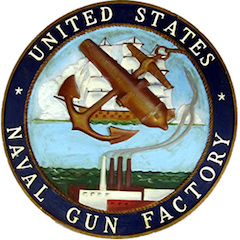 The U.S. Navy directly controlled some production capacity for shipbuilding and repairs at Navy Yards facilities, while some repairs could be made at bases or at repair ships overseas. The oldest continuously operating U.S. Navy base was and remains the Washington Navy Yard, this occupied 125 acres along the Anacostia River in Southeast Washington, D.C. Here were barracks and officers residences, administrative offices, and the design and manufacturing facilities where since 1799 ships and many of their instruments were built and maintained. The campus included the massive facilities of the Naval Gun Factory, where the Navy furnaces and machinery forged steel into immense gun breeches, barrels and barrel liners for installation on the battleships. Some of these guns were built for coastal artillery installations, and some were allocated for the mobile railway guns that were operated by the U.S. Navy and some by the U.S. Army too.
The U.S. Navy directly controlled some production capacity for shipbuilding and repairs at Navy Yards facilities, while some repairs could be made at bases or at repair ships overseas. The oldest continuously operating U.S. Navy base was and remains the Washington Navy Yard, this occupied 125 acres along the Anacostia River in Southeast Washington, D.C. Here were barracks and officers residences, administrative offices, and the design and manufacturing facilities where since 1799 ships and many of their instruments were built and maintained. The campus included the massive facilities of the Naval Gun Factory, where the Navy furnaces and machinery forged steel into immense gun breeches, barrels and barrel liners for installation on the battleships. Some of these guns were built for coastal artillery installations, and some were allocated for the mobile railway guns that were operated by the U.S. Navy and some by the U.S. Army too.
Since it was established on 13 October 1775 the ships of the U.S. Navy had always relied on telescopes and other optical devices for navigation, communications, and for control of their guns. Over the next decades binoculars and stadimeters (optical rangefinders) were added to the fleet and improved. Given the range of environments in which the fleet operates, optical service and repair facilities were established that became headquartered at the Washington Navy Yard; initially these performed repair and maintenance and were not involved in manufacture as that would be contracted. The Washington Navy Yard was a good place to work with secure good-paying jobs, with the Naval Gun Factory designing and building bigger and better guns and torpedoes, and a peacetime life lived conveniently near to the best of the nation’s capital. By the turn into the 20th century several shops, including the Optics Shop, even fielded their own baseball team.
As the geographic range of fleet operations expanded, remote support activities were established too that included optics repair and maintenance shops aboard dedicated repair ships and tenders; these were basically mobile ship and instrument repair facilities that would really prove their worth during World War I and decades later at Pearl Harbor and elsewhere during World War II.
Crown Optical Company: was a manufacturing company established in 1906 at 484 Clinton Avenue South, in Rochester, New York for the production of photographic lenses, and binoculars among other instruments. The company was located nearby the giants of American optics at the time, these were Eastman Kodak Company and Bausch & Lomb. This was a different time and era to be employed, benefits of working at Crown for example included an annual company outing held Labor Day at the nearby Sea Breeze (now Seabreeze) amusement park. Married and single men played each other in baseball among other events, in 1909 the married men won. Crown sales increased so they relocated into more suitable facilities three times so that by 1917 Crown had settled in at 203 State Street. Crown prospered in part because they were among several U.S. manufacturers awarded contracts to manufacture binoculars and other optical devices too for the militaries of the United States. Their binocular offerings were based on either the Galilean or Porro prism arrangements.
In the early years of World War I, before the U.S. became directly involved as a combatant, Crown was also among those companies contracted to produce optics for the military forces of several foreign governments. Their most-produced binoculars included their MILITARY STEREO 6x 30, a black or brown leather covered Porro prism model with individual focus (I.F.) and with hard flared eyecups; this arrangement remained popular and in production by one or another maker over decades to come. These binoculars bear no Crown company logo, but their prism cover will simply have the engraved information CROWN OPTICAL COMPANY, ROCHESTER, N.Y. U.S.A.. A number of these have survived and can still be found, some bear the broad arrow stamp indicating that binocular was originally contracted for and accepted for use by the British military, or it may bear an organization mark S2 and serial for example. Binoculars that had been discharged or sold out of service from the British military may bear the Crow’s Foot, an opposing and or overlapping arrows also termed a pheon symbol. Those binoculars made by Crown for the U.S. Navy bear U-S NAVY on one forward prism cover, with the ɴ symbol and Serial Number etched on the forward face of the other prism cover.
Prior to World War I and as is the case even today the manufacturers of optics and their accessories could not make every component of a binocular set in-house, but instead relied on alliances with subcontractors. Items that were subcontracted included carrying cases and carry straps, then these were typically made of leather. Even the optical components within a binocular might have been produced elsewhere, and only assembled at the facility that would stamp their name and city on the item. So Bausch & Lomb for example, with their increasing capacity to make raw glass, would fashion that into lenses and prisms to supply not only B&L branded binoculars but they supplied the same item to another binocular maker. This pattern would become the norm as becoming more efficient was vital to increasing overall production output in wartime.
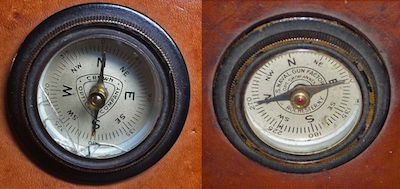 The accessories too might be subcontracted. For example, most military issue binoculars of World War I were issued with a leather carry case and strap. The lid of the case of some binocular models were fashioned with a circular cutaway in the lid, made to accommodate a magnetic compass for navigation by sight or when reading a map. Since it was not cost-effective for an optics company to tool up to manufacture something that a compass making shop already produced, the optics company subcontracted the compass. The same compass manufacturer supplied these for many other manufacturers, so the identical model of compass might bear the trade name Bausch & Lomb, or Crown Optical, or later the branding of the U.S. Naval Gun Factory Optical Annex.
The accessories too might be subcontracted. For example, most military issue binoculars of World War I were issued with a leather carry case and strap. The lid of the case of some binocular models were fashioned with a circular cutaway in the lid, made to accommodate a magnetic compass for navigation by sight or when reading a map. Since it was not cost-effective for an optics company to tool up to manufacture something that a compass making shop already produced, the optics company subcontracted the compass. The same compass manufacturer supplied these for many other manufacturers, so the identical model of compass might bear the trade name Bausch & Lomb, or Crown Optical, or later the branding of the U.S. Naval Gun Factory Optical Annex.
Left: examples of identical model subcontracted compasses, from the same maker, that were provided built onto the top of binocular leather carrying case lids. One at left bears the Crown Optical brand and the one at right is a later one made at the former Crown Optical factory but with the Naval Gun Factory Optical Annex brand (62,277 bytes).
The agencies contracting goods for the United States military came to realize the value of standardizing. So when there was a need to stockpile replacement compass window glass or complete new compass assemblies at a repair center nearer to the fields of combat, this was facilitated by the easy interchangeability of the parts.
U.S. Naval Gun Factory Optical Shop Annex: The United States declared war on the German Empire on 6 April 1917 and mobilization accelerated, but not without some hiccups. Crown Optical was among a number of contracted companies that were experiencing difficulties in meeting the increasing demands of the U.S. Government. So in 1917 Crown Optical was nationalized, the U.S. Government assigned the facility to the U.S. Navy who established the U.S. Naval Gun Factory Optical Shop Annex (NGF Annex) there in the facilities of the former Crown Optical. Manufacture of binoculars resumed and the rate of production increased so that by late 1917 the factory was supplying bureaus of the U.S. Navy, the U.S. Army, and others too.
After the acquisition by the U.S. Government the Crown Optical Company branding was discontinued and the company never returned to private ownership, there were no more optics bearing the Crown brand made after 1917*.
After the takeover of the facility by the U.S. Navy labeling was devised that incorporated an Navy Anchor logo. Each binocular was issued in a protective leather carry case with carry strap, initially the leather panel lining each case lid interior was stamped with the printed Anchor logo. The labeling of binoculars made soon after at production resumed at the former Crown factory will bear the U.S. Navy shop origin information in block letters, as below:
|
U.S.NAVAL GUN FACTORY OPTICAL SHOP ANNEX ROCHESTER,N.Y. U.S.A. |
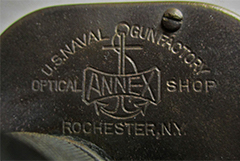
Later, well after the transition to U.S. Government ownership was implemented, the Anchor logo was stamped onto the binocular and other instruments produced at the U.S. Naval Gun Factory Optical Shop Annex at Rochester, N.Y. On Porro prismatic binoculars this labeling will be on the right side prism cover panel, while the left side cover will bear the model designation. The forward ends of the prism housing covers of those binoculars made at the Annex for the U.S. Navy will bear U-S NAVY on one forward prism cover, with the ɴ symbol and Serial Number etched on the forward face of the other prism cover, as they were before the U.S. Navy acquired the Crown factory.
Right: Anchor logo of the U.S. Naval Gun Factory Optical Shop Annex at Rochester, N.Y. on right prism cover of late World War I era 6x 30 binocular (134,493 bytes).
Mouse-over the image to see the Anchor logo of the U.S. Naval Gun Factory Optical Shop Annex on the same binocular case lid interior (158,902 bytes).
* Crown branded binoculars do come up in advertising or for sale used however, these are obviously made (with coated optics, etc.) by companies in Japan or elsewhere some decades after the original Crown Optical was appropriated by the U.S. Government. These post World War II produced optics will not have any relationship to the original Crown Optical company that was in Rochester, N.Y.
Right: optical repair shop aboard the USS Melville (AD-2) while stationed in Queenstown, Ireland; arriving on 22 May 1917 here she carried out repair and support operations during World War I. The ship became the flagship of Vice Admiral William S. Sims, Commander of U.S. Naval Forces in Europe, from 10 September 1918 to 4 January 1919 (51,383 bytes).
In 1919 the new building was completed and all the optics manufacturing equipment and personnel of the NGF Annex were relocated to the Washington Navy Yard. Here in their own 63,500 square foot Building 157 the optical shop craftsmen not only serviced but also designed and manufactured lenses and prisms, telescopes and stadimeters. Building 157 was distinct even from a distance because of it’s the tall towers used for the calibration of large rangefinders that would be sighted onto test targets miles away. The optical shop provided repair and maintenance services for a broad range of telescopes, range finders, binoculars, and spotting glasses. Their staff were also a resource for other organizations within the Navy that were establishing specifications to buy optical instruments from civilian contractors. This facility also hosted the U.S. Navy optical repair trade school. Another optical repair shop was later established at Mare Island Navy Yard, with facilities for repairing optical instruments of the Pacific Fleet.
As was the case with the big guns and many other items produced at the Washington Navy Yard, optics production too accommodated needs of organizations outside the Navy. At least as far back as 1917 some models produced by the Naval Gun Factory Annex optical shop were built for other branches of service including the US Army Signal Corps. Well after the annex factory at Rochester was relocated in 1919 to the Washington Navy Yard, many components produced in Rochester remained in their stocks after World War I. The urgency after Pearl Harbor demanded any stock on hand be pressed into service, so one may find binoculars assembled decades after some of their parts were made bearing a prism cover engraved with the “NGF Annex Rochester NY”; an example of these were marked Military Stereo 6x30 binocular (SN 31xx) and dated 1942.
Organization While Approaching War:
Going into World War II the United States Navy Department was an independent branch of the military. Each military branch of service was supported by their own administrative and logistical operations. As each had different missions, the requirements for their hardware was often specified by each branch of the military service. Furthermore, since each branch of the military operated a variety of missions then hardware for the specific missions too was specified or adapted to suit.
U.S. Navy organizations that were largely responsible for procurement in 1940 were designated Bureaus, each commanded by a Rear Admiral. These Bureaus included: Aeronautics, Engineering, Navigation, Ordnance, and Ships. So the fleet of surface combat and support ships, of submarines, of Coast Guard and of Maritime Service vessels, along with most of their instruments and consumables too, were largely specified by and contracted for by the Bureau of Ships (BUSHIPS, or sometimes designated BU.SHIPS). Navy personnel, charts and weather monitoring were managed by Navigation (NAV). Optics required for the aviation mission were administered by the Bureau of Aeronautics (BU.AERO), while optics for gunnery support for everything from antiaircraft to the big guns of the battleships would be acquired through the Bureau of Ordnance (BU.ORD). This fiscal year also saw a major reorganization of the Navy Department, putting all material under management of the Bureau of Ships.
Adapting And Standardization For War:
Late in the 1930’s the prospect of war became more obvious to the American Congress; planning had commenced and manufacturing had been contracted to modernize the military. In the United States a strong Executive and cooperative Congress passed legislation that enabled and even streamlined wartime procurement for the U.S. and for allied nations. In 1938 the Washington Navy Yard Optics Shop alone had produced some 5,893 instruments. However, the military alone lacked the in-house manufacturing capacity necessary to meet the demands of a World War so ships, aircraft, armor, guns, and anything else needed for war including binoculars too were manufactured under contract.
After Japan attacked Pearl Harbor and Germany declared war on the United States, America dramatically increased the rate and scale of mobilization. The United States adapted for wartime production rapidly and with total commitment; the population had become galvanized by Pearl Harbor, and it too mobilized to conserve vital materials (rubber, nylon, gasoline, etc.) and contribute metals and other materials for recycling into weapons.
The ramping up of manufacturing to operate at up to 24 hours per day, and 7 days per week happened very quickly. Where practical an existing design might be adapted for use in some new application, as much as possible standardizing and sharing parts between old and new; it was not time or materials efficient to devise a completely new product for every mission.
Right: Square D SARD binoculars undergoing assembly, note the ladies contributions to the war effort (58,686 bytes).
Many companies formerly making products for the consumer were geared up to manufacture wartime commodities. At first glance it often seemed that many companies were manufacturing items for war that had little to do with what the company had manufactured in peacetime, but manufacturing expertise is manufacturing expertise. Automobile companies built armored vehicles and tanks, aircraft, and small arms. Franklin Instruments of Pennsylvania, who manufactured clocks before the war, continued to make such instruments but also adapted to manufacture pedestal-mounted ’Big Eye’ 120mm binoculars along with Kollmorgen Optical Co. in Massachusetts. Many new companies too sprouted up to compete for their share of lucrative defense contracts.
In the field of optics two of the more notable established manufacturers of binoculars in the United States were Bausch & Lomb Opt. Co. of Rochester, New York, and Spencer Lens Company (American Optical), of Buffalo, New York. There was much cooperation between the manufacturing companies, so Bausch & Lomb could provide prisms and lenses or complete instruments to other companies for integration into their larger systems. Wartime production designs were standardized as much as practical so that parts made by one company could be interchanged with parts made by another during final assembly, this was especially helpful for streamlining repairs at facilities closer to the combat areas. To that end Bausch & Lomb licensed it’s designs and assisted six other companies including Kollsman Instrument Co., Universal Camera Corp., and Anchor Optical Corp. to gear up for mass production while also standardizing the binoculars.
Those models that were mass produced during the war for hand held uses included 6x 30mm, 7x 35, 7x 50, 8x 56, 10x 50, and 10x 70. There were comparatively fewer numbers of some specialty or experimental models made including the 6x 42, and the 9x 63 that is featured in this article. For use in low light conditions of dawn, dusk, night or during inclement weather the 7x 50 was a most popular choice. For shipboard use or reconnaissance on land then the 7x 50 tended to be preferred, with excellent balance for hand holding, a reasonably wide (Approx. 7.2 Degree) field of view, and large exit pupil that made them comfortable to line up and look through. Where light gathering power was less a concern or where being able to carry or wear were as important then the smaller binoculars were issued.
Going into or during World War II a number of companies had manufactured binoculars for other services and for other bureaus of the Navy however, the manufacturers contracted to fabricate hand held binoculars specifically for the BU.ORD were:
C.F. or I.F.? For reasons of practicality military binoculars tend to be built with the Individual Focus (I.F.) mechanical arrangement, this is where the user rotates the upper barrel of the left and right eyepiece independently to focus the binocular to infinity. Once the focus has been set it need not be changed and is not likely to shift on its own; every time you pick up the binocular the view will be sharp and with no time wasted adjusting the single focus dial as on a Central Focus (C.F.) binocular that do tend to shift focus at times almost just sitting still. I.F. is especially desirable at sea in foul weather since precious seconds might be wasted trying to determine what is the best focus point while looking out for another ship coming at you in a fog for example. Since each I.F. binocular eyepiece bears a calibrated diopter scale (indicating + and - diopter symbols) it is a simple matter to share a binocular with someone even if they need to change the setting, since upon return of the binocular the primary user can reset the focus without even having to look through the glass. The I.F. arrangement makes perfect sense since in most naval or airborne uses the binocular would be adjusted to the infinity focus for observing objects hundreds of feet away if not miles distant. Furthermore, this arrangement is much easier to produce in a waterproof configuration, and will be far more resistant to the elements or impact than binoculars made with a C.F. arrangement. A birder or nature watcher who constantly change focus for optimum observing of objects that may be very close then out to infinity would find the C.F. arrangement to be more convenient.
The Issue Binocular Mark and Mod Designations: a binocular that is well suited for one type of use within any one or multiple branches of service might not have been as well suited for use in another application. The particulars could have to do with matters of magnification and field of view, aperture and low light capabilities, or durability at sea or in an aircraft environment, even special lubrication and seals for extremely cold climates. Subtle differences could include design of the provided eyecups, or rubber face guards (for better comfort over extended observing sessions). For some missions it could be important to make provisions for the binocular to accept or be provided with filters, such a facility could be cause to designate the new or modified binocular as a separate model or variant of a model. To abbreviate missions for which a product was designed the armed forces employ acronyms, line or mark item numbers, or other devices. In the case of military binoculars the Navy relied on a term “Mark x”, and this may bear some additional suffix “Mod x” designation.
A binocular that was meant to be left attached to the conning tower of a submarine or it’s deck gun would have to be made to endure shock and pressures of water from waves, so BU.ORD set forth the specifications for what became the Mark 38 and BU.ORD administered the contracting to have these manufactured by government contractor Bausch & Lomb.
Left: image of a binocular that incorporates a Compass Bearing with Ranging Reticle (117,110 bytes). Courtesy Company Seven.
However, all production binoculars were not standardized to incorporate a reticle because some agencies preferred not to have this distraction, this might be the case for those engaged in sweeping the skies for aircraft or panning the horizon looking out for an approaching vessel or downed fliers. Furthermore, the reticle pattern could be specific for the use, one for a typical combat soldier and another someone guiding ordnance who had to judge the distance of approaching aircraft for example.
Versions of the Mark 28 handheld 7x 50 binocular were ordered by the Bureau of Ships (BU.SHIPS) and also by the The Bureau of Aeronautics (BU.AERO); these were improved general purpose models assembled since 1943 and with eyepieces that do not incorporate a reticle. The same basic Mark 28 binocular manufactured for BU.SHIPS and for BU.AERO were also contracted by BU.ORD and these were assembled as a variant that incorporates a reticle, this configuration was designated the Mark 39 Mod 1. Some modifications could have been made during the course of servicing, that could confuse someone searching out an old binocular. So for example it was possible for an optics technician to install a new reticle from stock or to remove it, so one might encounter a Mark 39 Mod 1 binocular without it’s reticle, or a Mark 28 with reticle.
The Mark 28 binocular manufactured for BU.SHIPS were also contracted by the U.S. Marine Corps and these were designated the Mark 46. The Mark 46 was at first glance identical to the Mark 28 however, this variant incorporates a reticle in the left eyepiece. Not only were there new Mark 46 binoculars manufactured for the U.S. Marine Corps, but owing to a shortage of new Mark 46 binoculars by 1944 it was authorized to modify some Mark 28 to Mark 46 and these will bear labeling to indicate this on their right prism housing cover (the spaces before the "NO." would be the marked out original number):
The type and quantity of each binocular, as was the case with virtually every piece of equipment, were allocated by the Navy Ship Allowance List. Every U.S. Navy, Coast Guard, and Maritime Service vessel, from the Battleships down to a PT boat, and cargo vessels too would have so many binoculars of a particular Mark designation allocated to it: no more and (hopefully) no less. In keeping with military necessity there were specialists trained and certified to perform maintenance and repairs, these could be civilian employees working at a Navy base or sailors assigned to warships and auxiliary vessels including ships that specialized in providing repairs. In the case of most Navy binoculars they referred for guidance to some “Manual for Overhaul, Repair and Handling of xx Binoculars with Parts Catalog”, we for example refer to a later copy of the NAVSHIPS (formerly BU.SHIPS) publication No. 250-624-2 from 1951.
The year stamped on a binocular prism cover will represent when that specification was first contracted, that does not necessarily indicate when a particular binocular was manufactured. So for example, a Mark 28 binocular bearing the 1943 imprint on the prism cover might have been manufactured in 1945. Some production lots will bear a serial number or a production date code, this may be the letters code and numbers stamped on the hinge front cover of many B&L binoculars for example. Unfortunately many binoculars ordered for BU.AERO and by others too may bear no serial number or date code. It is only by understanding these markings, then comparing them to factory production records, then one might be able to date a binocular. But consider too how so many years after production it is also possible that components may have been interchanged between similar binoculars; a binocular that shows signs of tampering or repair is less likely be 100 percent original.
Right: typical optical arrangement of the wartime U.S. Navy 7x50 handheld binocular (117,444 bytes).
A particular binocular design might have been needed in such large quantities that multiple companies would be contracted to meet the demand. Consider the Mark 32 7x 50 binocular, production of this model was assigned by BU.SHIPS to: Anchor, National, Universal, and some were even contracted to Perfex though that contract was cancelled in 1945. Each contracted Mark 32 production lot bore a ’Mod x’ designation to reflect the assigned manufacturer. So the Mod 0 suffix indicated that Mark 32 was made by Anchor, the Mark 32 Mod 1 was the designation assigned to National, and so on. A binocular trade name might not exactly correspond to the company name that was assigned the contract, for example we have read of some BU.ORD binocular contracts awarded, before the United States entered the war, to “BUSCH TURLUX” when in fact the maker was Emil Busch A.G., of Rathenow in Germany.
The Bureau of Ordnance designed, specified, and often manufactured optical devices. When demand for lower numbers of some specialized product were called for then the Bureau of Ordnance might contract the work to the optical shop at the Washington Navy Yard Naval Gun Factory (N.G.F.). However, the N.G.F. production capacity was comparatively limited, so when the Bureau of Ordnance required a large quantity of binoculars then these were contracted, and during the war most of these would come from B&L. Binoculars contracted by Bureau of Ordnance and used in World War II will bear “U.S. NAVY” along with either designation “BU.ORD” or “BU OF ORD.” Company Seven is aware of some twenty-four (24) basic models amounting to thirty-seven (37) models and variants of BU.ORD contracted binoculars.
Most of the 7x 50 Porro prismatic binoculars made for the US military were based on the highly successful B&L 7x 50 I.F. model that well predated World War II. The successive models, though improved, closely resembled the B&L U.S. Navy Mark 1 and by design many parts were interchangeable. The B&L 7x 50’s were among the more mass-produced binoculars of the war. Their general purpose series culminated in the B&L Mark 28 Mod 0, an example SN 156177 is in our collection, although they departed from the formula to develop and produce for the Bureau of Aeronautics the highly acclaimed Bausch & Lomb Mark 41, a 7x 50 Wide Angle binocular. Models similar to the B&L were made by other companies including Square D who marketed under the SARD trademark and produced their last 7x 50 of the war, the Mark XLIV. One of the last new designs of note made for the war was the Mark 45 Mod 0, a 7x 50 made by Hayward for BUSHIPS; this is explained in our article about the 7x 50 models that features our own SARD Mark XLIV.
Right: marking on right prism cover of U.S. Navy Mark 28 Mod 0 binocular made in 1943 by Bausch & Lomb, typical 7x 50 military issue of this era (38,515 bytes). This very much like new binocular has it’s original leather strap attached, and was issued with leather case and eyepiece green ND filters. Exhibited at Company Seven’s museum collection.
The uniformity and standardization of designs streamlined not only manufacture, but also facilitated maintenance and repair or even the upgrading or modifying of some equipment during the course of the war. For use in some theaters a particular Mark and Mod binocular may have had two desiccator modules installed, one in each prism housing, while doing this for some other models (the Mark 39 Mod 1 for example) was explicitly prohibited by BU.SHIPS. The media holding some cemented objective lenses together might fail in a particularly harsh climate so an alternative, even if more costly to make, might be authorized just for fitting to binoculars destined for use in that region. Many wartime 7x 50 binocular models incorporated 52mm diameter objective lenses with a 190mm focal length, this explains why so many 27mm focal length eyepieces and 50mm finder telescopes were still being furnished with amateur telescopes being sold new well into the 1980’s: their sellers were simply modifying surplus new old stock lenses and eyepieces to fit.
Anti-Reflection Coatings: new technologies were coming out almost daily and for optics this included antireflection coatings developed in 1935 by the Carl Zeiss Jena company. Dr. A. F. Turner of the Scientific Bureau of the Bausch and Lomb Co. developed a more durable Magnesium-Fluoride (MgFl) treatment that are optimized for the yellow-green, this region of the visual spectrum is the peak of sensitivity for the human eye. These coatings are only four-millionths of an inch thick but when applied on all air to glass surfaces, increased light transmission through a binocular and in the case of a 7x 50 this might mean an increase of from 57.8% to 75% overall and with a reduction of ghosting and flare. First applied for commercial optics by B&L in 1939, by 1941 they were approved for service use and were finding their way into military optics. By 1943 the lenses and prisms of most U.S. military binoculars were being made with these AR coatings*. As binoculars were returned to service centers for repairs or maintenance, upgrades such as changing older uncoated lenses to the newer antireflection coated optics could have been retrofitted to some Mod versions. After the war these coatings were marketed by B&L under the trade name “BALCOTE®”.
The Navy technical manuals specified some of these improvements that were to be made, these might involved improved sealing against water to be performed by using later production improved components to replace original obsolete parts. So for example, the Mark 32 binocular was made in seven different Mods (0, 1, 2, 4, 5, 6, 7) but whenever earlier Mods of the Mark 32 binocular arrived for service they would be upgraded to the Mark 32 Mod 7 configuration that improved waterproofing of the eyepiece. We have observed B&L Mark 1 binoculars that were originally made in 1940 with uncoated optics, that since have been refurbished by the Navy shops to incorporate improved coated optics; the refurbishment process typically had the binocular so well overhauled, replacing chipped eyecups or dented front rings, that the binocular left the Navy shop performing and often appearing pretty much as new. The Navy manuals even specified what special tools and skill level was required to service each binocular; an Optical Instrument Assembler, Junior Grade being sufficiently skilled to perform disassembly and routine maintenance of most handheld 7x 50 binoculars while repairs and reassembly would be assigned to an Optical Instrument Assembler, Senior Grade.
U.S. Navy World War II production and World War I era binoculars too are not particularly scarce today. However, given the age of most of these old binoculars it is rare to find one today that has not been bound up by old grease, or beat to heck in hard use. Lacking specific tools, documentation and training no amateur should attempt to disassemble and clean or repair any of these binoculars, that is if they ever hope to use them again.
Why? the 7x 50 had become the standard U.S. Navy hand-held watch binocular, indeed for decades before the 7x 50 had been and remains to this day the shipboard preferred choice by most mariners. The U.S. Navy 7x 50 models show a reasonably wide field of view, an area over seven degrees wide. The 7x 50 is easy to hold steady even on the rolling deck of most smaller ships and submarines. It provides an optimal Exit Pupil diameter of 7.1mm, arrived at by dividing the 50mm aperture by the 7x magnification, that could fill the open aperture of a dark adapted eye. These factors combined with coated optics throughput of about seventy five percent (75%) result in a binocular that provides something one the order of thirty-eight times the light gathering power of the unaided eye; a good choice for work in low light.
After the notable U.S. ship and personnel losses during several major naval surface actions against capital ships of the Imperial Japanese Navy* feedback mounted pointing out deficiencies. U.S. Navy capital ships needed to improve their fighting capabilities, among the highlighted areas of need was their capacity to fight a surface action at night.
* including the Battle of the Java Sea (27 February to 1 March 1942), Battle of Sunda Strait (28 February 1942), Battle of Savo Island (9 August 1942), Battle of Cape Esperance (11 October 1942), First Naval Battle of Guadalcanal (13 November 1942), Second Naval Battle of Guadalcanal (14-15 November 1942), Battle of Tassafaronga (30 November 1942).
The U.S. Navy had commenced installation of early RADAR (their acronym for RAdio Detection And Ranging) on ships late in 1940. The U.S. Army began to put land based systems into the field in 1941, including most ironically the SCR-270 mobile system deployed to Oahu just prior to the attack on Pearl Harbor whose warning about aircraft approaching 132 miles away from the northwest was dismissed. Then, even though U.S. Radar technology was several years ahead of the Japanese, those U.S. systems aboard ships were still evolving while commanders were learning how to rely on it. Later in the war the U.S. shipboard systems would be able to not only find the enemy ships but also track their own the outgoing 16 inch shells. While we were improving and learning how to employ Radar, ways to improve on more traditional optical systems were also being explored.
The combat experience gained by fighting the Imperial Japanese Navy in the early fleet surface actions of 1942 and 1943, and the increasing application of big ships for coastal naval bombardment too identified a need to furnish Captains and Fire Control Officers aboard the Battleships (BB) and Cruisers (CB, CA, CL) with a binocular that would provide better resolution of distant objects, to allow improved gauging the fall of their ship’s heavy gun shells, and to show views in low light or adverse weather conditions. The binocular was made to be hand holdable, but BU.ORD also specified it would be compatible with binocular mounts Mark 1 and Mark 2. The need was pressing, but the demand was estimated to require the production of only five to seven thousand binoculars. It was determined the scale of this task could be managed in-house, so the Bureau of Ordnance contracted the task to their Optical Shop at the Washington Navy Yard Naval Gun Factory (N.G.F.).
Right: U.S. Navy Mark 28 Mod 0, a most successful general purpose 7x 50 binocular manufactured by Bausch & Lomb from 1943 to 1944, alongside a Mark 37 (49,361 bytes). Both are exhibited at Company Seven’s museum collection.
For several years after the war B&L would market these U.S. made 7x 50 Mark 28 Mod 0 binoculars, sans the U.S. Navy contract and Mark/Mod designation markings, for the civilian market. Later B&L would be among the first American companies to sell their soul, teaching the then cheaper labor pool in Japan how to take the American jobs. After sending production overseas B&L never regained their reputation as a first class competitor for optical products made by the likes of Carl Zeiss.
A basic design principle of naval binoculars called for maintaining an optimal Exit Pupil diameter of about 7 mm, this had driven prior developments including the 7x 50, and the 8x 56. If the next solution was to maintain that optimal ratio, and 9x was being considered next, then this pointed to 9 × 7 = 63 mm diameter objective. This would provide something one the order of sixty-one times the light gathering power of the unaided eye, or about 1.6 times the light gathering power of the 7x 50.
Yankee Ingenuity after arriving at the conclusion that a new binocular was needed, and this was to be a 9x 63 then there was the matter of time to contend with; designing and tooling up to produce a completely new binocular would add months to any project. In that time many more naval battles might be fought, and more lives and ships lost or damaged. The designers reviewed the designs of the existing binoculars and considered what could be done to use as many of the components already in production as possible to speed the implementation.
The typical U.S. Navy issue 7x 50 mm binocular, as depicted in the drawing above, consists of 50 mm objective lenses at the front each with a focal length (basic magnification) of 190 mm. To arrive at 7x requires using an eyepiece of 27.1 mm focal length. If one were to use the prisms and eyepieces of an existing production 7x 50 binocular and mate these to 63 mm objective lenses with a focal length of about 244 mm, then since 244 ÷ 9 = 27.1 that would net the desired 9x magnification.
The focal ratio (f/) of the 50 mm objective lens used to build the binocular, the ratio of their focal length to diameter, is f/3.8. That of the intended new 63 mm binocular would be a similar f/3.9. The designers determined the existing prisms and eyepieces of the 7x 50 binocular body could deal with the light path produced by the planned for 63 mm objective lenses.
There had been at least one prior precedent for performing such a conversion though it is possible the team working on the 9x 63 project may not have known this. Engineers at Ernst Leitz Optische Werke, in Wetzlar Germany sought a way to create a larger aperture binocular by adapting an existing production model, this resulted in the 15x 60 mm AVIOTUR. It is believed these were produced in 1917 for the Luftstreitkräfte (air force) and Kaiserliche Marine (Imperial Navy). This strongly resembles the Leitz 7x 50 Porro II binoculars made through World War II, but with barrel extensions and larger lenses.
The final result of the development work by the team at the N.G.F. optical shop was assigned the designation Mark 37, and the drawings became U.S. Navy General Arrangement No. 254211-O.
Conversion and Production: the team at the N.G.F. optical shop commenced work with a complete B&L U.S. Navy issue 7x 50 binocular, removing the front barrel assemblies including their 50 mm objective lenses. Next they fashioned a new front end assembly incorporating an extension tube that would compensate for the added 54 mm focal length of the objective lens. For expediency this extension section was not covered as were the 7x 50 portions of the binocular, but this extension was instead painted in a textured flat black. The extension was threaded to accept the machined lens cell (holder) that would accommodate the new 63 mm diameter lens, and the result worked.
Above: the basics of how they arrived at the final arrangement of the 9x 63 Mark 37 binocular (50,363 bytes).
The binocular objective lens actually consist of two lenses joined together to work as a matched set; one element is made of crown glass and the other is a flint glass element. The lenses are cut and precisely ground and polished to a specific prescription. The lenses are then assembled and glued together as a matched set, that is inspected then tested. The air-spaced surfaces, r for radius with r1 indicating the front surface and r4 indicating rear, are treated with Magnesium-Fluoride antireflection coatings (explained above). This doublet lens is carefully set into a precisely machined lens holder, the lens cell, and a retaining ring is threaded over the lens to keep it in place. Each lens set is serial numbered, that number and the designation indicating left or right was written by pencil on the edge of the lens. So to this day you can look into the front end of the Mark 37 binocular and read it’s serial number on the lens edge, that will usually match the serial number engraved onto the prism housing cover.
Note: the yellow coloration is from the Canada Balsam, and optical adhesive used to join and maintain the two lenses together.
We do not know what the numbers 025 and 016 indicate that follow the serial numbers. In service an objective lens might be damaged so that the binocular would be sent back to an optical repair shop; if the lens had to be replaced with new stock, then it would likely bear a different serial number than that of the binocular.
Mark 37: Binocular With An Identity Crisis? The upper assemblies of Mark 37 were converted from 7x 50 binoculars that were all originally contracted by BU.SHIPS or BU.ORD from either Bausch & Lomb Optical Company, or from Anchor Optical Corporation, both in New York state. All 7x 50 binoculars selected for the conversion to Mark 37 were either old new stock, or binoculars turned in from the field that were completely overhauled, updated (with new MgFl antireflection-coated eyepieces and prisms), and restored to function and appear much as they were when new. Some new production Bausch & Lomb 7x 50 binoculars were also selected for conversion to Mark 37.
The Bausch & Lomb and Anchor 7x50 binoculars selected for conversion included:
Some of these older binoculars were produced with optics (objective lenses, prisms, and eyepieces assemblies) that predated antireflection coatings, so owing to light lost by reflections of air to glass surfaces these binoculars originally were only about 57.8% efficient at transmitting light and their contrast was not as high as that of more recently developed coated optics. So their optical components were replaced with recently manufactured prisms and eyepieces assemblies that were treated on all air to glass surfaces with MgFl antireflection coatings. The overall light transmitting efficiency of the coated binoculars were about 75%. In practical terms the binoculars with coatings provide a brighter image than uncoated models, with better clarity, and improved contrast. These are particularly helpful when in adverse observing conditions: glare from the surface of the sea, from the sun or other off-axis bright lights or gun flashes, in the low light of dusk or dawn, etc.
The Prisms Cover Identifying Engravings: if the binocular was originally US Navy issue, then it would bear the original indication of having been a 7x 50 model contracted for the U.S. Navy with that labeling on the right prism cover. Those binoculars originally intended for the civilian market, or for some other US Government agencies, would bear the pre and post-war Bausch & Lomb civilian labeling on the right prism, and with only the 7x 50 labeling on the left prism cover.
All of these Bausch & Lomb binoculars were originally produced with a front hinge cap bearing the manufacturer’s serial number; this can be all numbers for production up to 1940, or a two-letter and four- digit serial for 1941 and later. The US Navy issued their own Model, Mark and Serial Number to identify the particular binocular within that Model and Mark series; this number is all numerals.
Right: eyepieces and engraved prisms covers of our U.S. Navy Mark 37 binocular (21,027 bytes). Exhibited at Company Seven’s museum collection.
The right side prism housing cover of the Mark 37 may bear the factory stick-on warning label with yellow lettering THIS INSTRUMENT HAS “COATED OPTICS” CLEAN LENSES CAREFULLY. The warning labels, all likely sourced from the same printer, were provided to other binocular makers of this era.
Our Mark 37 has no coated optics sticker, the original engraving was scratched out but not painted over, so we can clearly read both left and right prism cover engravings:
Note Mark 37 binoculars bearing serial numbers from about 3600 and higher will have the information arranged differently with their Serial Number centered on the last line, not aligned left as on previous production models. The year of production was omitted from the labeling of those Mark 37s produced in this serial number range.
Fit, Feel, Weight: the body of the Mark 37 (7x 50) is made of cast aluminum with other components being stamped or machined. All construction components are nonferrous so that the binocular will not distort a compass. The prism clusters are mounted onto a support shelf, that rests on lugs cast into the binocular body. The hinge is substantially constructed with a precision machined post ½ inch in diameter. Again, other than the objective lens and cells, the optics and mechanics and the basic fit and feel in the hands too will be identical to whatever B&L 7x 50 binocular the Mark 37 was built upon.
The Mark 37 binocular stands about 9-⅝ inches tall, a little taller or shorter depending on eyepiece diopter setting, with a typical width of about 8-½ inches, with this depending on IP spacing. The Mark 37 weighs about 3.85 lbs. (1739 grams), that is 1.3 times the weight of a typical 7x 50. The additional weight seems to be little price to pay for the higher magnification and the previously noted 1.6 times increase of light gathering power over the 7x 50.
For comparison of size and weight consider our our SARD Mark XLIV 7x 50 stands 7-7/16 inches tall, with a typical width of about 7-¾ inches. Weighing about 2.92 lbs. (1322 grams) the SARD Mark XLIV weighs about 2 percent less than the B&L Mark 28 that weighs 2.98 lbs. (1350 grams).
All of these binoculars feel good in the hands in terms of the fit of it’s castings profile. They reassure the user that these are not cheaply constructed. As these were designed and then produced for actual “your life may depend on this” kind of service, the focus was on performance and reliability and not so much on cost. And the U.S. Navy was able to make enough of these to meet their demands and field them in a fraction of the time it might have taken to commence design and production of an entirely new binocular.
Eyecups or with Eyeshield: the Mark 37 were intended for use by Captains and for big gun commanders aboard the capitol ships. These officers were stationed on the Bridge, Gun Directors, and Gun Turrets. To better accommodate each user Mark 37 binoculars were contracted to be furnished with either hard Bakelite (plastic) eyecups alone, or with the eyecups fitted with a flexible wrap-around rubber eye shield.
Bakelite was the first production synthetic plastic originally developed developed in 1907. This plastic was selected for the production of eyecups over metal for example for a number of reasons including: ease of milling, it is more durable and resistant to rot than rubber, comfort when observing in extremely cold climates. If the binocular was impacted or dropped then the plastic could buffer the shock, even if cracking or breaking off this reduced the likelihood of damaging the fine metal male thread of the eyepiece assembly.
Right: eyepieces and eyecups of our Mark 37 binocular, with one eyecup removed to reveal the male thread and better show the eyepiece construction (33,384 bytes).
The eyecups can be removed to accommodate: optional filters, flexible rubber winged eye guards, or for extended observing it can accept an entire padded face rest. The eyecups are made with an inner female thread that we measured at approximately 30.4 mm diameter. These eyecups thread onto the male thread of the eyepiece top; this measured 30.3 mm (right) and 30.4 mm diameter (left) on our Mark 37 example. Keep in mind that several machine shops were likely manufacturing parts for final assembly into eyepieces so the tolerances of parts from one lot to another or shop to shop could vary somewhat though they had to be made within certain specified tolerances; this certainly predates Computer Numerical Control (CNC) milling machines.
The shield was provided as a replaceable slip-on accessory for (if not with) Mark 37 binoculars. This resembles a mask that one might wear to a festival but is made of black rubber, flexible and molded to fit the face of most users. The shield of the Mark 37 was originally developed to fit rangefinders and other optical devices providing: 1. shielding against glaring off-axis light such as the flash from gunfire off to the sides of an observer, from red lights at night or from intense glaring daylight, and 2. this helps the user align and maintain the eyepieces at their eyes. This mask, or a variant, was also provided as an accessory for other U.S. Navy binoculars including some 7x 50 models too; since these were the basis of the Mark 37 the shield would fit this 9x 63 too.
To attach the shield onto the binocular the standard eyecups are removed, then these are replaced with a thread-on machined metal adapter ring. The adapter ring resembles an eyecup at first glance but it’s top edge is flat and nearly flush with the level of the eyepiece eye lens. This adapter is machined to incorporate a flange around the outer radius. The rubber mask has two openings for the observers eyes, the inner radius of each opening is molded with a groove so that the mask can slip over and fit onto the flange of the eyepiece adapter. Some surviving Mark 37 binoculars still retain the shield adapter, threaded onto the eyepiece instead of standard eyecups, but most of these have long ago lost or worn out their original rubber shield.
Being flexible and with a narrow cutout joint between the eyes, it is easy for the user to extend or retract the binocular barrels to adjust the binocular for their own interpupillary spacing.
In hot and humid climates especially, the insulating properties of the rubber shield could render this uncomfortable to use. When attached to the binocular they add some notable bulk. So the shield could be readily slipped on or off the binocular.
The hard rubber carrying case of the Mark 37 were made to accommodate the binocular with eyecups, though not with the shield attached. The shield may have been issued with every Mark 37 made as part of an accessory set, that likely included the shield with two eyepiece adapters. A BU.ORD document about the Mark 37 in Company Seven’ archive makes mention of a hard rubber accessory and the number 105901, but we have not yet chased down the meaning of that note.
As an aside, some people refer to these asma faceshield but this is a misnomer since the shield really only covers that upper part of the face necessary to shield the eyes. The shield, termed by some since well after the war a 'Baker Shield' after a prominent maker of these.
Performance: performance is good with bright and sharp clear images presented to the observer. The Mark 37 eyepieces of our example provide an approximate 50.8 degree apparent field of view, this results in a 5° 38.8′ (5.64°) wide true field of view. The eyepieces are of a fairly simple design that do not deal well with curvature of field of lenses as fast as these f/3.9. The central 20 percent of the field, judging by diameter, is crisply focused. However, under careful study the sharpness and clarity of the outer regions decline radiating from the center and getting worse as one nears the edges of the field of view, this affects about 40 percent of the total field of view by area. To some degree this is typical of most binoculars made in this era, and even today only the most superbly designed and crafted and most costly models will do better in this aspect.
The Navy specifications data in our Archives indicates 13.5 mm was the Eye Relief, we measured 14.9 mm eye relief from the Eye Lens to the focal plane and this too is similar to the eye relief of their 7x 50’s cousins. The flared eyecups take up about 4.4 mm of this, so anyone wearing prescription spectacles or sunglasses would be working with something over 10.5 mm eye relief. We have not tested many other U.S. Navy binoculars of this era (yet), but the eyepieces of these wartime general purpose models are made similarly we expect similar apparent fields of view and eye relief since it was built upon several of the popular 7x 50’s of the day.
But overall there would be nothing extraordinary about the Mark 37 in these respects.
Since life and death could depend on these binoculars, great effort and expense were paid to insure they provided every optical edge, are durable, resistant to shock, and water resistant. The Navy required these Mark 37 and the 7x 50 binoculars from which they were assembled to pass several tests including:
The Carry Case: most handheld binoculars made for the civilian and military markets were similarly equipped with a set of accessories including carry case, a case handle strap or shoulder strap, and an adjustable length carry strap for the binocular. The carrying and storage case and carry straps accompanying most issued binoculars were made with either a hinged lid or one attached by a flexible flap. The binocular slips into the carrying case eyepieces end first, the prism housings bearing the load by resting on support blocks built-in at either side of the case floor. The case interior lid might have provisions for storing accessories such as a pair of neutral density filters or polarizing filters.
Binoculars produced for the military during the early years of the war were furnished with a hard leather case and straps, many completed later were issued from the factory with a hard synthetic case and straps. Those cases made of molded synthetics that at first glance would seem to be made of a hard plastic, and these were accompanied by flexible nylon straps that could survive the heat and humidity of the Pacific and other tropics better than leather. These cases shed rain, are essentially maintenance free, and weigh less than a leather case. The molded rubber cases were also less costly to fabricate than the sewn leather cases. Some companies contracted to provide binoculars had the in-house manufacturing capability to produce the accessories, including leather cases, but setting up a new production line simply to mold cases of rubber was not practical and so these cases were contracted. So the largest scale binocular models manufactured by B&L, Spencer, and SARD transitioned from leather to the contracted hard rubber cases. However, some models of binocular (including B&L Mark 21, B&L Mark 24, B&L Mark 41, SARD Mark 21, SARD Mark 43, etc.) were issued with a fitted leather case throughout the war years.
Some cases made by Hood for a binocular will bear a manufacturer logo, these include cases made for Bausch and Lomb, for the Spencer where their company logo is embossed atop the case lid. However, all cases will still bear the HOOD logo, and case model designation (B3, B6, B12 for example) embossed at the exterior bottom panel of the case. The several different cases made to accommodate a 7x 50 binocular may at first glance appear identical but there can be subtle differences; for example a case made for a Bu.AERO binocular might need extra space below the lid to avoid compressing the winged rubber eyecups, and to accommodate the longer eyepiece and filter barrels, so Hood made provisions to fit these. Of course, after deployment to the field all bets were off as we are certain the carry cases and various binoculars often became mixed up.
Our evidence points to the original issue case of the
Right: rubber case made by Hood Rubber Products Company, Inc. for the Mark 37 binoculars. (111,035 bytes).
The carry case with lid has an overall height of about stands 12-⅛ inches tall, the opening for the binocular has an overall width 8-⅜ and is 3-⅝ deep (front to back) at the top. The case profile tapers somewhat, so that the bottom of the case is 7 inches wide but remains 3-⅝ deep. The carrying straps for the case and for the binocular too were also made of synthetics including Nylon. The Mark 37 case is basically a taller and wider version of the cases made for other hand held U.S. binoculars, with a hinged lid but with a snap fastener and short carrying strap. The fastener arrangement of the Mark 37 differs from the typical 7x 50 cases that employ a long strap spanning from the lid, across the front of the case and fastens at the case bottom. The Mark 37 case is provided with riveted flexible black nylon short fixed length strap, this was never made to be carried casually hanging from the shoulder. The case weighs just over 2 lbs. At the bottom center of the case is the
“Made In Japan” Carry Case for the U.S. N.G.F. Mark 37? There have been several used Mark 37 binoculars that have come available for sale over recent years that are accompanied by a stitched black leather covered hard case with adjustable length leather shoulder carrying strap. The stitching is white, the snap fastener hardware is chromed, and the interior of the case is lined with red plush fabric. Even at a glance the white stitching and red lining raised our curiosity since this did not look like any other wartime military issued binocular leather cases. Company Seven has examined several of these black leather cases, including the case that accompanied our Mark 37. The cases show few signs of age or wear, certainly not corresponding to the wear patterns on the Mark 37 binoculars. After only a cursory examination we concluded these red lined cases were actually made in Japan well after World War II; ours still bears an “PASSED E.C.M.C.J.” inspection sticker from the Japanese trade industry. While some collectors mention having a leather case for their Mark 37 binocular these tend to be post war adaptations.
The leather case is an odd size, too large to accommodate most consumer binoculars being made then, yet it is a perfect fit for the Mark 37. Since several of these cases being sold with Mark 37 binoculars appear identical we speculated about how this came to be? Certainly in 1944 the U.S. Government did not negotiate with their enemy Japan to buy these leather cases for only some of their new Mark 37 binoculars. However, it is plausible, in order of likelihood, that either:
As mentioned above, our Mark 37 binocular arrived well protected within a postwar produced hard shell black leather case. This case is attractive and functional however, since this was not original World War II issue, and since we are not certain about the origins of these cases we do not exhibit this case.
Production Numbers:
U.S. Navy BU.ORD records in the archives at Company Seven indicate they contracted for the production of five lots of Mark 37 binoculars; their records are not always comprehensive and can have some mistakes. The first three lots of Mark 37 were completed for certain, and at least some of the fourth planned lot were produced before the remainder were cancelled. A production note dated November 1945 mentions a total of 4,706 Mark 37 binoculars were assembled.
That note mentions these were predominantly from converted Mark 1 binoculars, this also mentions some 450 Mark 37 binoculars were produced by converting Mark 26 binoculars, the latter basically a B&L Mark 13 made for BU.ORD but originally fitted with rubber eye guards. As mentioned above, we at Company Seven have observed the first Mark 37’s were built upon Mark 2 Mod 2 binoculars made in 1943, then Mark 1 Mod 2 binoculars manufactured in 1941, 1942 and in 1943. We have also studied Mark 37’s made from converted Mark 26 Mod 6 binoculars originally manufactured in 1942, and Mark 32 Mod 4 binoculars made in 1943 by Anchor. We cannot be certain whether or not other 7x 50 models were converted to Mark 37.
By late 1944 it was determined that Radar and other developments had negated the need to manufacture additional Mark 37 binoculars. It is possible that Mark 37 production may have stretched into 1945, models made in 1944 bear that year on their prism cover plates though the prism covers for those Mark 37 binoculars made after SN about 3600 do not bear any year designation.
* After further planned new production was cancelled, SN 4706 appeared to have been the last Mark 37 completed for the war according to BU.ORD records in our archives. However, Company Seven has data about Mark 37 binoculars in the 47xx serial number range. This leads us to conclude that either 1. our World War II era BU.ORD records have an error or 2. these binocular 4707 and higher were assembled after World War II from parts, possibly for replacements or decommissioned ships of the Korean War.
Parts support for the upper 7x 50 components of the binocular remained excellent well into the Vietnam war era. As far as components specific to the 63mm objectives and cell, Company Seven’s archives of U.S. Navy documents do refer to at least some new machined repair parts being made to support repairs of the Mark 37 objectives and cells as late as in 1956.
Binoculars serviced by the U.S. Navy would have been repaired using approved replacement original parts. Since some of these Mark 37 binoculars were certainly in service well into the Vietnam war era then parts stocks were likely still sufficient then to justify keeping the Mark 37 on the approved binocular issue lists. As happened during the prior two wars, a Mark 37 could have been so comprehensively overhauled that it may have left the optical shop appearing much as new, even with new lenses installed for example. We have read accounts that we cannot prove or disprove of some new Mark complete Mark 37s having been assembled from spare new parts mated to other compatible U.S. Navy 7x 50 binoculars as late as in the 1970’s; we have seen no proof of this.
There are however, some Mark 37 binoculars that have been serviced by third parties and they may have used whatever parts were close at hand to perform repairs. So it is possible to find a Mark 37 with a military or post war civilian issue 7x 50 prism cover instead of the original, the finish of the new and old parts rarely match. Eyecups changes are fairly common since an amateur can unthread the original and fit a third party replacement, or fit some winged eye shield.
Our Mark 37:
The James Bond Connection:
Right: this Mark 37 binocular with its eye shield attached, is the prop used in the 1964 movie (45,217 bytes).
The Mark 37 binocular filmed in the scene was owned by the films’s assistant art director Michael John White. On 21 March 2015 this Mark 37 with it’s brass tripod adapter was sold at an auction in Cologne, Germany for 6326.85€ (Euro), somewhat over the 6000€ minimum asking bid. The binocular, showing some wear after some fifty years after filming, was accompanied by a letter of authenticity from Diana White, Michael’s wife.
We at Company Seven found it amusing that this binocular was advertised for the auction as being a “Bausch & Lomb Binoculars 7 x 50”, no doubt the sellers may have read some remnants of the engraved markings on the right prism cover and did not know enough to understand the objective lenses were not 50mm in diameter, this was definitely a 9x 63 Mark 37. However, since in the sales literature there was no mention of or explanation about any original serial number markings appearing on the binocular the only aspects to tell this binocular from any other Mark 37 might be the wear pattern of the original paint on the objectives extensions. Though if someone knowledgable could inspect it then it is certain that at least Mark 37 Serial Number could be discerned, and possibly the original Bausch & Lomb U.S. Navy Mark and Mod information might be readable too.
The marketing material for the sale pointed out “Goldfinger” was a highly successful movie, remaining popular even today, and is significant for introducing the ingenious gadgets and technology which feature in all Bond later films, leading a Times critic to write: “All the devices are infinitely sophisticated, and so is the film.” And so a Mark 37 took its place among the other iconic pieces of Bond film history.
The Mark 37 was conceived and built during an era when big guns mattered. However, as the actions at the Battle of the Coral Sea fought in May 1942 and the Battle of Midway in June 1942 were assessed, it became apparent that air power would increasingly dominate engagements at sea. Radar and the tactics to employ this new technology were developing quickly. Battleships and cruisers of the U.S. Navy were relegated to providing anti-aircraft support for Aircraft Carrier Battlegroups, and for support of amphibious landings by providing precise bombardment of shore installations. The largest battleships of the Imperial Japanese Navy were sunk by air power never having the chance to try their 18 inch guns against any of the American big gun ships. As the United States adapted to the new realities of war the contracts to build additional battleships and cruisers were scaled back, or cancelled altogether. The Mark 37’s required to equip the battleships and cruisers, including spare stock requirements too, had pretty much been met by those 4,706 completed in 1944 and so the contract for subsequent planned production was cancelled.
After World War II most of the the U.S. Navy big gun ships were decommissioned and put into storage (“mothballs”). Some were reactivated for Korea, and some were brought back into service even years later for Vietnam and the war in Iraq. But their weapons would be guided against targets well beyond the horizon by electronics, not optics.
Many World War II era binoculars were retained in service and in reserve by the US government and civil defense agencies. A large quantity of these binoculars and spare new parts too were retained in military warehouse stocks. To streamline logistics and cut the need to support so many varieties of products, the variety of Marks supported was reduced. By 1951 for example what SARD 7x50 Mark XLIV binoculars had been contracted during World War II had been phased out as they came in for repair or service, any new spare stock and repair parts specific to the Mark XLIV had been declared surplus. Through the 1950’s the Navy still employed the Mark 28 Mod 0, Mark 32 Mod 7, Mark 39 Mod 1, and the Mark 45 Mod 0. These binoculars were still being issued for service in the Korean War, and later for the war in Vietnam. Support for the Mark 37 was pretty easy to rely on since all parts but the 63mm objectives lenses and their front barrel extensions were identical to those of Navy 7x 50 binoculars that remained well supported even beyond the Vietnam War era. We spoke with one Navy veteran who was aboard the aircraft carrier USS Shangri-La (then CVA-38) from 1966 to 1968, he recalled the Mark 37 that was in service aboard ship - and somehow he happens to have come across one of his own.
Aside from the Boeing B-52, few products made for the U.S. military have survive daily use for decades, and Mark 37s in the field simply started to wear out. They were becoming too few in numbers to justify maintenance and parts channels, and something was needed to equip new ships too. So 10x 70 binoculars were contracted to take their place most notably there are the ones produced by Fujinon, and sold by Company Seven, that came into service aboard the large ships of the Navy. The remaining Mark 37 were declared surplus, discarded, or simply ended up at some sailors homes. Today these are not the most common World War II era U.S. Navy binoculars to be found coming available on the used market, but with patience one in serviceable condition could be acquired. Most other U.S. World War II production binoculars are not particularly scarce and many remain in use, but as with the Mark 37, it is rarer and rarer to find one in original truly excellent used or like new condition. Those who seek a Mark 37 for practical use today would likely do better to buy a modern Fujinon 10x 70 or a Carl Zeiss 8x 56 binocular.
Washington Navy Yard, Naval Gun Factory, and Optical Shop
At its peak productivity the Washington Navy Yard was the largest naval ordnance plant in the world that included 188 buildings laid out across 126 acres of land, and employing nearly 25,000 people. The massive manufacturing facilities of the Naval Gun Factory were transitioning away from making gun barrels even well before the war ended, since pending orders for new battleships were canceled. The surrender of Germany in May 1945 and the atomic bombings of Hiroshima then Nagasaki, with some 200,000 or more casualties over time, resulted in a hasty end of the war. The atomic bombings then surrender of Japan in August 1945 had taken the American public, including many manufacturers, by surprise. It would take some time for the men at arms to be gradually discharged, return to civilian life, and create demand for consumer goods. Manufacturers were left with a surplus of employees (many plants had operated shifts of workers 24 hours a day and 7 days a week), machinery, factory space, and buildings full of new binocular parts.
In December 1945 the Washington Navy Yard was renamed the U.S. Naval Gun Factory. Work to develop weapons for the fleet continued there until 1961, by then this work had been relocated to contractors and other U.S. Navy facilities. In 1963 control of 55 acres of the Washington Navy Yard Annex, the western side of Yard, was transferred to the General Services Administration. The the facility was renamed back to its original designation, Washington Navy Yard, on 1 July 1964.
Right: USNGF Optical Shop building interior, site of one of the optical manufacturing areas shown vacant (45,489 bytes).
Manufacturing in the United States had been so gutted by the time of the Regan administration that when he ordered a build up to a 600-ship Navy that included resurrecting all four of the Iowa class battleships of World War II (still the most survivable, and best constructed warships ever in the U.S. Navy), questions arose about whether or not this could be done since NO COMPANY IN THE USA was left that could manufacture the barrel liners for their big 16 inch guns. Fortunately some stock of these were found stored since the Korean War at the Subic Bay Naval facility. Talent too had been lost; Vietnam era battleship veterans had to be found and employed to teach the next generation of sailors how to even operate and maintain these ships. Over recent years a fair amount of the original complex was handed over to GSA. When money ran tight and common sense prevailed many leased military offices at Crystal City, Virginia were relocated to The Washington Navy Yard. So now most people employed there would not know how to turn on a lathe, though many of them can design a part and send the blueprint to a company elsewhere that can (if that manufacturing too has not already been off-shored to China).
Contrary to much popular political chic of years since the 1960’s, military service is very beneficial for teaching people skills, discipline, and for earning self-respect. The people who learned a trade at the Washington Navy Yard either retired, or went on to find gainful employment elsewhere. It is a fact that most of the well-regarded small optical manufacturing shops that were established in the Baltimore-Washington region owe their start to founders who learned their craft at the Washington Navy Yard Optical Shop. While none of these men who founded their companies in the late 1940’s and 1950’s are still with us, their children and their companies employees of today owe them and the U.S. Navy a debt of gratitude.
Conclusions:
Today the binoculars made for the Nazi military tend to command the highest regard among collectors, and the resale prices reflect that. Often the claims are fantasy; how many people have marketed a German consumer hunting binocular as having been Kriegsmarine or Rommel’s Africa Corps issue? How many Kriegsmarine shore anti-aircraft artillery or tug boat binoculars have been marketed as U-Boat issue? No doubt Nazis made some fine binoculars, they also made a fine 88mm gun - we made dozens of 76’s while they built one 88, we made hundreds of Shermans while Hensoldt built one Tiger I tank, we launched a new ship faster than they could sink them, and so on. So maybe scarcity somehow factors into selling price; a high percentage of Kriegsmarine optics are at the bottom of the sea after all. Or is there simply some perceived aura about that Nazi Eagle and Swastika that gets some collectors juices flowing? Whatever the reasons, to our mind the U.S. made optics rarely garner the respect they deserve.
The state of the art binoculars of today, using the popular 7x 50 for comparison, include the Fujinon 7x 50 FMT-SX, and the Carl Zeiss 7x 50 B GA T∗ Nautik marine binocular. In the 70-ish mm class Fujinon and Nikon rule; if carefully compared then these modern binoculars are in several ways better than those made seventy-two years ago. But the modern binocular really does not seem to show all that dramatic an improvement over those made in World War II, not what we would have expected given all the years they have had to be improved. Those of today certainly do not approach the wide field views of those stunning Bausch & Lomb Mark 41 7x 50 and SARD Mark 43 6x 42 models. As one compares the view and durability through a World War II issue U.S. Navy binoculars against the best models of today, one appreciates better what a fine accomplishment Bausch & Lomb, SARD, U.S. Naval Gun Factory, Anchor, Spencer, and others attained.
But never forget these were built by those of the The Greatest Generation at a time when lives often depended on a binocular, these helped them to win a World War.
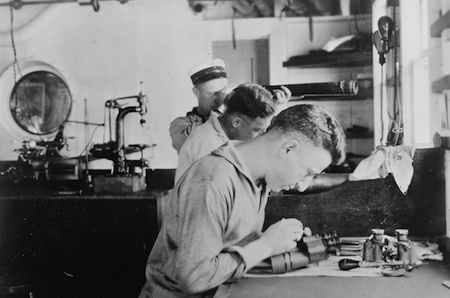 Wartime production planning had called for the U.S. Naval Gun Factory Optical Shop Annex to be relocated from Rochester, New York to a new larger building at the Washington Navy Yard complex, this was part of overall expansion of production there that was scheduled to reach full manufacturing capacity in 1922. However, on 11 November 1918 before this move could commence the “War To End All Wars” ended, coming sooner than American industry anticipated.
Wartime production planning had called for the U.S. Naval Gun Factory Optical Shop Annex to be relocated from Rochester, New York to a new larger building at the Washington Navy Yard complex, this was part of overall expansion of production there that was scheduled to reach full manufacturing capacity in 1922. However, on 11 November 1918 before this move could commence the “War To End All Wars” ended, coming sooner than American industry anticipated.
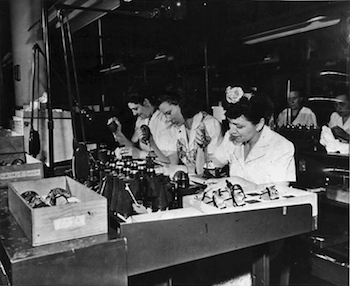 The Emergency Training for National Defense organization trained potential hires to read blueprints, use drafting equipment and measuring micrometers, and to operate basic manufacturing equipment so these students too could be readied to be hired by manufacturing companies. By January 1942 it was also apparent to organizations, including the Board of Education in many states, that most manufacturing and other jobs too would be opened to women. So the education programs and facilities too were modified to accommodate that reality. They opened supplementary and pre-employment courses to anyone male or female aged 17-½ or older for positions in the defense industries. In New York City however, they initially resisted placing women into these jobs as they had some 300,000 men listed on unemployment rolls; the U.S. was still coming out of the Great Depression after all but this was rescinded early in 1942 and women were placed onto a more equal footing for training and employment. As women joined the work force this freed manpower from manufacturing to join the armed services and civil defense organizations.
The Emergency Training for National Defense organization trained potential hires to read blueprints, use drafting equipment and measuring micrometers, and to operate basic manufacturing equipment so these students too could be readied to be hired by manufacturing companies. By January 1942 it was also apparent to organizations, including the Board of Education in many states, that most manufacturing and other jobs too would be opened to women. So the education programs and facilities too were modified to accommodate that reality. They opened supplementary and pre-employment courses to anyone male or female aged 17-½ or older for positions in the defense industries. In New York City however, they initially resisted placing women into these jobs as they had some 300,000 men listed on unemployment rolls; the U.S. was still coming out of the Great Depression after all but this was rescinded early in 1942 and women were placed onto a more equal footing for training and employment. As women joined the work force this freed manpower from manufacturing to join the armed services and civil defense organizations.
The U.S. Military Issue Hand-Held Binoculars:
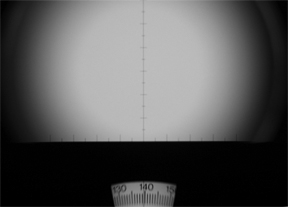 Many military issue handheld binoculars were built incorporating a reticle, this is a pattern of lines built into an eyepiece and overlying the field of view. The reticle aids the observer in determining distances, spotting the fall of artillery (aerial, mortar, or naval guns) and more.
Many military issue handheld binoculars were built incorporating a reticle, this is a pattern of lines built into an eyepiece and overlying the field of view. The reticle aids the observer in determining distances, spotting the fall of artillery (aerial, mortar, or naval guns) and more.
By assigning an easy to reference Mark designator to a production series this also expedited communicating about them between the Navy organizations. As newer improved production came available it was easier to identify and replace older models. For example, in September 1943 the Bureau of Ordnance communicated to all Navy Yard optical officers an order to obsolete all Binocular Marks from 1 to 12, among other optical components (periscopes, telescopes, rangefinders) being phased out; this basically commanded those older binoculars no longer be repaired but replaced when possible.
U.S.MARINE CORPS
NO.serial number, 1944
MOD.FROM MK. 28 TO MK. 46
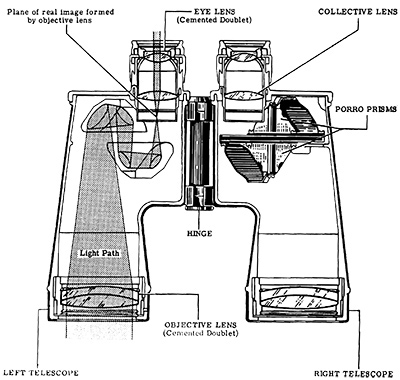 The Path To Production: once a new requirement was identified the government would solicit proposals, at times even paying for some of the up front costs of design. After the designs were approved then the detailed production drawings (blueprints) would be prepared that included: Outline View (exterior), General Arrangement, and Optical Arrangement. A “General Arrangement Mark xx” number was assigned to the manufacturing drawings and to the contract paperwork. The suffix of each number indicated the originator, with O indicating BU.ORD, S indicating BU.SHIPS, C indicating a customer’s drawing. A General Arrangement letter suffix might indicate it originated in the Navy even if it was made for the another branch of service, the U.S. Army by BU.ORD for example. This process facilitated distributing the necessary design information that would insure consistency among the various assigned manufacturers. In time the contracting process changed from referring to these items by General Arrangement number and instead assigned a Federal Stock Number (FSSN) or to each product.
The Path To Production: once a new requirement was identified the government would solicit proposals, at times even paying for some of the up front costs of design. After the designs were approved then the detailed production drawings (blueprints) would be prepared that included: Outline View (exterior), General Arrangement, and Optical Arrangement. A “General Arrangement Mark xx” number was assigned to the manufacturing drawings and to the contract paperwork. The suffix of each number indicated the originator, with O indicating BU.ORD, S indicating BU.SHIPS, C indicating a customer’s drawing. A General Arrangement letter suffix might indicate it originated in the Navy even if it was made for the another branch of service, the U.S. Army by BU.ORD for example. This process facilitated distributing the necessary design information that would insure consistency among the various assigned manufacturers. In time the contracting process changed from referring to these items by General Arrangement number and instead assigned a Federal Stock Number (FSSN) or to each product.
Click on image to see enlarged view (132,514 bytes).
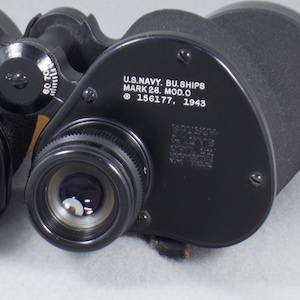 U.S. Navy binocular Mark designations of this era could be Arabic or Roman numerals. The binocular itself may bear either, and technical documents might refer to the same instrument by either nomenclature. All SARD Mark 44 binoculars for example bear “Mark XLIV”. SARD made other models of binocular for the war, these other models including the Mark 21 made for the Aeronautical Bureau of the U.S. Navy for example bear the designation in Arabic numerals. In order to simplify reading of the designations, on 17 April 1944 BuShips ordered the designation labeling be standardized, moving away from use of Roman numerals and to Arabic numbers for products contracted from then on. We at Company Seven do not know why the Mark designations assigned before this were a mix of Arabic and Roman numerals, but we remain open to information that would explain why.
U.S. Navy binocular Mark designations of this era could be Arabic or Roman numerals. The binocular itself may bear either, and technical documents might refer to the same instrument by either nomenclature. All SARD Mark 44 binoculars for example bear “Mark XLIV”. SARD made other models of binocular for the war, these other models including the Mark 21 made for the Aeronautical Bureau of the U.S. Navy for example bear the designation in Arabic numerals. In order to simplify reading of the designations, on 17 April 1944 BuShips ordered the designation labeling be standardized, moving away from use of Roman numerals and to Arabic numbers for products contracted from then on. We at Company Seven do not know why the Mark designations assigned before this were a mix of Arabic and Roman numerals, but we remain open to information that would explain why.
Click on image to see enlarged view (115,710 bytes).
* The lenses of World War II era binoculars provided with the AR coatings exhibit a distinct purplish tint. Those accustomed to older uncoated optics and not acquainted with the new coatings might after noting the tint become concerned that something had contaminated the binocular, this resulted in many early binocular coatings being damaged by people trying to clean off the AR coating. Coatings could be damaged by improper cleaning techniques too. As a result manufacturers applied labels warning users about the coatings. For those who seek more information about proper cleaning techniques, Company Seven hosts an article Cleaning Telescopes And Most Consumer Optics.
The US Naval Gun Factory Mark 37 - 9x 63 Binocular:
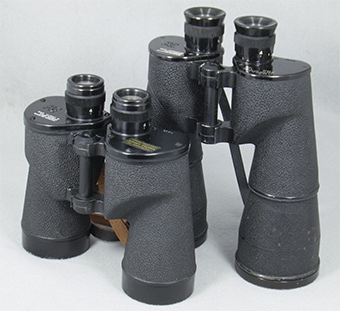 The N.G.F. optical shop had previously looked into developing a practical larger aperture binocular to proceed greater light-gathering power, their experiments resulted in building the prototype 10x 70 Mark 25, and the Mark 25 Mod 1 binoculars. But these 70mm binoculars had proved to be bulky, heavy, and difficult to hand hold steady for any length of time. The Mark 24 developed by B&L for BU.AERO is a 8x 56 binocular offering a good balance of performance and usability, it is a good choice for low light work but at typical gunnery distances on the high seas of fifteen (yes, 15) miles or so the 8x magnification would not quite resolve the detail required by a ship Captain in a running surface action. Since this new binocular was meant to be used aboard larger and comparatively steadier ships it was concluded that 9x could be the most practical magnification.
The N.G.F. optical shop had previously looked into developing a practical larger aperture binocular to proceed greater light-gathering power, their experiments resulted in building the prototype 10x 70 Mark 25, and the Mark 25 Mod 1 binoculars. But these 70mm binoculars had proved to be bulky, heavy, and difficult to hand hold steady for any length of time. The Mark 24 developed by B&L for BU.AERO is a 8x 56 binocular offering a good balance of performance and usability, it is a good choice for low light work but at typical gunnery distances on the high seas of fifteen (yes, 15) miles or so the 8x magnification would not quite resolve the detail required by a ship Captain in a running surface action. Since this new binocular was meant to be used aboard larger and comparatively steadier ships it was concluded that 9x could be the most practical magnification.
Click on image to see enlarged view (199,848 bytes).
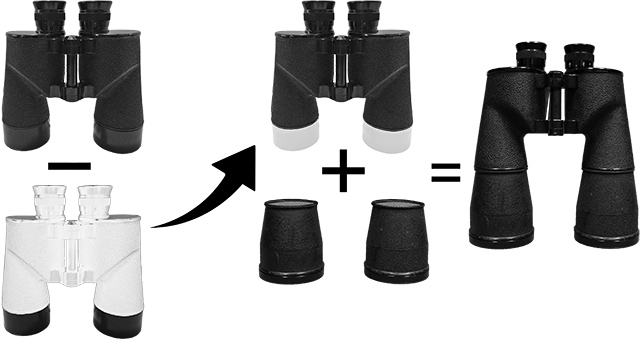
Commence with the 7x 50, remove the original objective lenses and their cells, attach the new barrel extensions with their 63 mm objectives.
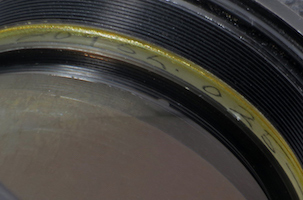
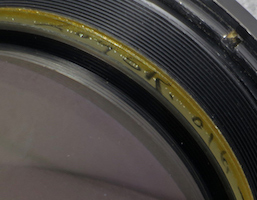
Above: Serial numbers (2095) written in pencil identify the left and right objective lens sets assigned to our Mark 37 binocular SN 2095.
As they are installed in the lens cell the writing will appear backwards to the eye, so the images were reversed so the writing can more easily read.
The left reads “2095L - 025”, the writing on the right lens edge reads “2095R - 016” (images 37,564 and 33,739 bytes).
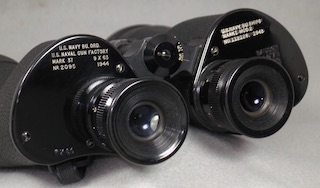 Bausch & Lomb never produced the Mark 37. Instead these were conversions contracted by BU. ORD. and produced at the US Naval Gun Factory, so they are listed as the manufacturer on the binocular labeling. So as is the case in our sample Mark 37, it was built upon a U.S. Navy BU.SHIPS MARK I Mod 2, Serial No. 112128 contracted in 1943; a model of 7x 50 binocular that were designed and manufactured during World War II specifically for assignment to U.S. Navy surface ships. However, when a 7x 50 binocular was selected for conversion to Mark 37 then their original markings were carefully scratched out with an engraving machine, on later models possibly painted over. A ’COATED OPTICS’ warning label would have been affixed over the scratched out original markings or on the left prism cover, or applied onto the left prism cover.
Bausch & Lomb never produced the Mark 37. Instead these were conversions contracted by BU. ORD. and produced at the US Naval Gun Factory, so they are listed as the manufacturer on the binocular labeling. So as is the case in our sample Mark 37, it was built upon a U.S. Navy BU.SHIPS MARK I Mod 2, Serial No. 112128 contracted in 1943; a model of 7x 50 binocular that were designed and manufactured during World War II specifically for assignment to U.S. Navy surface ships. However, when a 7x 50 binocular was selected for conversion to Mark 37 then their original markings were carefully scratched out with an engraving machine, on later models possibly painted over. A ’COATED OPTICS’ warning label would have been affixed over the scratched out original markings or on the left prism cover, or applied onto the left prism cover.
Click on image to see enlarged view (65,296 bytes).
U.S. NAVY BU.ORD
U.S. NAVAL GUN FACTORY
MARK 37 9X63
Nº. 2095 1944
U.S.NAVY. BU.SHIPS
MARKI. MOD.2
NO.112128. 1943
U.S. NAVY BU.ORD
U.S. NAVAL GUN FACTORY
MARK 37 9X63
Nº XXXX
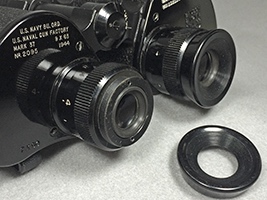 The design of eyecups could be flared, with the inner radius approaching the eye lens having a shallow V tapered profile; these were typical of those provided on the earlier war production binoculars, and are what our binocular was fitted with when when we acquired it for exhibit. Or the eyecups fitted could be more of a cylindrical profile, as were delivered on later production models and are seen on our exhibited BUSHIPS SARD Mark XVIV 7x 50, our B&L made BU.SHIPS Mark 28 Mod 0 7x 50, and our B&L made BU.AERO Mark 24 8x 56. Our Mark 37 example arrived with the flared eyecups, the same type as were provided with the new Mark I Mod 2 binoculars upon which our Mark 37 was built.
The design of eyecups could be flared, with the inner radius approaching the eye lens having a shallow V tapered profile; these were typical of those provided on the earlier war production binoculars, and are what our binocular was fitted with when when we acquired it for exhibit. Or the eyecups fitted could be more of a cylindrical profile, as were delivered on later production models and are seen on our exhibited BUSHIPS SARD Mark XVIV 7x 50, our B&L made BU.SHIPS Mark 28 Mod 0 7x 50, and our B&L made BU.AERO Mark 24 8x 56. Our Mark 37 example arrived with the flared eyecups, the same type as were provided with the new Mark I Mod 2 binoculars upon which our Mark 37 was built.
Click on image to see enlarged view (134,043 bytes).
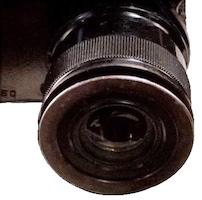
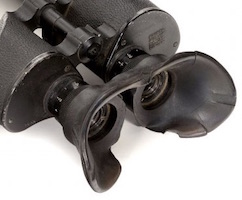
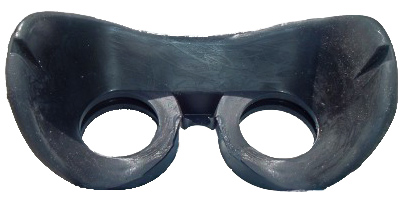
Above left to right: Mark 37 binocular with machined adapter threaded onto the eyepiece, ready to accept the slip-on shield.
A shield installed on the binocular, and to the right is the shield detached and showing the wearers side (22026, 15664 and 34969 bytes).
![]() The company contracted by most manufacturers of U.S. military binoculars to produce molded cases was the Hood Rubber Products Company, Inc. of East Watertown, Massachusetts. The factory was founded in 1896 by Frederic and Arthur Hood. Hood produced a variety of rubber and plastic-coated goods including automobile pneumatic tires and rubber tubes, rubber and rubberized footwear, gloves, floor tiles, battery boxes. During World War I Hood also manufactured several models of the Hood rubber boots that were used by French, British, and American armed forces. Hood prospered and grew to become the third largest rubber products company in the USA: their factory became a complex of more than sixty buildings with a combined floor space of more than forty-five acres. In 1929 B.F. Goodyear purchased the company, though the Hood Rubber Company name and logo continued to be used until the late 1950’s. During World War II Hood manufactured bullet-proof fuel cells, de-icers for aircraft, dinghies, plastic helmet liners, aviation boots - and yes cases for binoculars. The factory operated until its closure in 1969.
The company contracted by most manufacturers of U.S. military binoculars to produce molded cases was the Hood Rubber Products Company, Inc. of East Watertown, Massachusetts. The factory was founded in 1896 by Frederic and Arthur Hood. Hood produced a variety of rubber and plastic-coated goods including automobile pneumatic tires and rubber tubes, rubber and rubberized footwear, gloves, floor tiles, battery boxes. During World War I Hood also manufactured several models of the Hood rubber boots that were used by French, British, and American armed forces. Hood prospered and grew to become the third largest rubber products company in the USA: their factory became a complex of more than sixty buildings with a combined floor space of more than forty-five acres. In 1929 B.F. Goodyear purchased the company, though the Hood Rubber Company name and logo continued to be used until the late 1950’s. During World War II Hood manufactured bullet-proof fuel cells, de-icers for aircraft, dinghies, plastic helmet liners, aviation boots - and yes cases for binoculars. The factory operated until its closure in 1969.
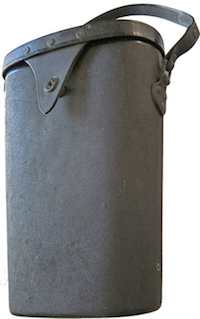
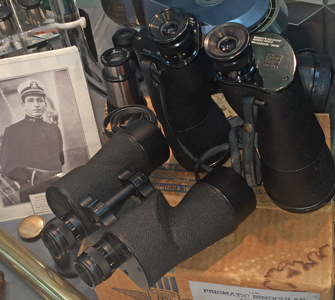
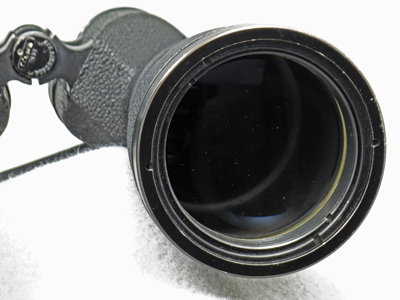
Above right: a spotless Mark 37 left 63mm diameter objective lens installed in lens cell, the assembly set into the front of the extension section (49,077 bytes).
Click on images to see enlarged views (217,135 and 108,721 bytes).
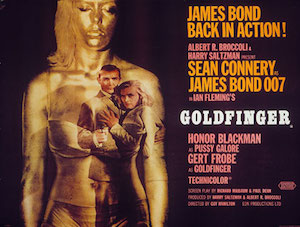 Who would have ever thought that the preferred choice of binocular by an arch-villain bent on world domination would be the U.S. Navy Mark 37 9x 63? In 1964 “Goldfinger”, the third movie of Ian Fleming’s James Bond series, was released. Early in this movie a scene is set at the outdoor terrace of the Fontainebleau Hotel on Miami Beach where we find a guest, gold magnate Auric Goldfinger (played by Gert Fröbe), playing gin rummy against an opponent who is losing badly.
Who would have ever thought that the preferred choice of binocular by an arch-villain bent on world domination would be the U.S. Navy Mark 37 9x 63? In 1964 “Goldfinger”, the third movie of Ian Fleming’s James Bond series, was released. Early in this movie a scene is set at the outdoor terrace of the Fontainebleau Hotel on Miami Beach where we find a guest, gold magnate Auric Goldfinger (played by Gert Fröbe), playing gin rummy against an opponent who is losing badly.
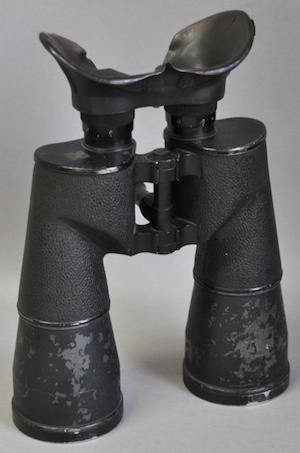 The fictional MI6 agent “007” James Bond (Sean Connery) observes Goldfinger is cheating by having his opponent’s cards read by employee Jill Masterson (actress Shirley Eaton), a beautiful blond woman who is observing them from a hotel room balcony above and behind the patsy through a tripod-mounted Mark 37 binocular. The woman communicates the cards information to Goldfinger by radio through what appears to be his hearing aid. Bond enters the hotel room and distracts Jill, then over the radio Bond blackmails Goldfinger into losing the remaining hands. Of course Bond gets the girl, then he is subsequently knocked out by Goldfinger’s Korean manservant Oddjob (actor Harold Sakata). Bond later regains consciousness to find Jill is dead and covered in gold paint, having died from “epidermal suffocation” in what became one of the iconic images of the movie, as shown in the movie advertising poster at left, so much so that an image of gold-painted Shirley Eaton as Jill Masterson appeared on the cover of the then popular magazine Life.
The fictional MI6 agent “007” James Bond (Sean Connery) observes Goldfinger is cheating by having his opponent’s cards read by employee Jill Masterson (actress Shirley Eaton), a beautiful blond woman who is observing them from a hotel room balcony above and behind the patsy through a tripod-mounted Mark 37 binocular. The woman communicates the cards information to Goldfinger by radio through what appears to be his hearing aid. Bond enters the hotel room and distracts Jill, then over the radio Bond blackmails Goldfinger into losing the remaining hands. Of course Bond gets the girl, then he is subsequently knocked out by Goldfinger’s Korean manservant Oddjob (actor Harold Sakata). Bond later regains consciousness to find Jill is dead and covered in gold paint, having died from “epidermal suffocation” in what became one of the iconic images of the movie, as shown in the movie advertising poster at left, so much so that an image of gold-painted Shirley Eaton as Jill Masterson appeared on the cover of the then popular magazine Life.
Click on image to see enlarged view (89,409 bytes).
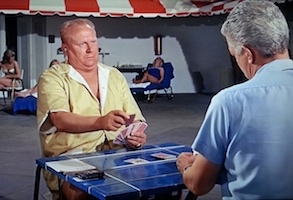
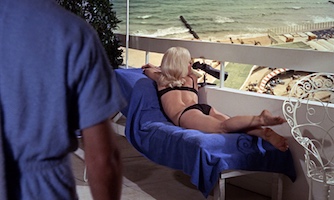
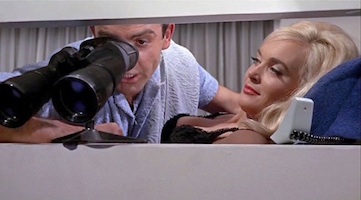
Above left to right: Auric Goldfinger cheating at cards, Bond walks in on Jill spying opponents card’s with Mark 37 binocular,
Bond communicates to Goldfinger the jig is up (images 36,902, 36,832 and 33,945 bytes).
Click on images to see enlarged views (357,380, 169,166 and 75,506 bytes).
Binoculars Post War
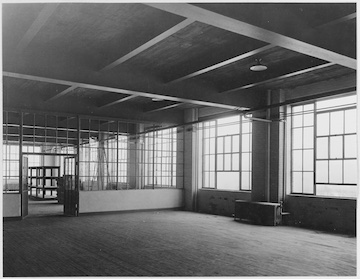 The Washington Navy Yard campus became underutilized as production there declined. The surrounding neighborhoods of Anacostia and other areas of Southeast Washington, D.C. in particular declined as middle class jobs were lost to “beltway bandits” (contractors who often perform the same work of now displaced civil servants or military employees, but at much higher cost) in the suburbs, and as white flight from the area surrounding the Washington Navy Yard commenced. As the Washington Navy Yard campus become more and more vacant bureaucrats and Virginia politicians likely lined somebody’s pockets, for some decades having the U.S. Navy pay rent to house NAVSEA (successor to BU.SHIPS) staff and others in leased offices and at premium rates in a newly built cluster of buildings at Crystal City, Virginia. Some seventy plus years later the Washington Navy Yard is still in business, though it might be hard to recognize it since the manufacturing that helped win two World Wars, and fight the Korean War too has largely been shut down and the facilities dismantled.
The Washington Navy Yard campus became underutilized as production there declined. The surrounding neighborhoods of Anacostia and other areas of Southeast Washington, D.C. in particular declined as middle class jobs were lost to “beltway bandits” (contractors who often perform the same work of now displaced civil servants or military employees, but at much higher cost) in the suburbs, and as white flight from the area surrounding the Washington Navy Yard commenced. As the Washington Navy Yard campus become more and more vacant bureaucrats and Virginia politicians likely lined somebody’s pockets, for some decades having the U.S. Navy pay rent to house NAVSEA (successor to BU.SHIPS) staff and others in leased offices and at premium rates in a newly built cluster of buildings at Crystal City, Virginia. Some seventy plus years later the Washington Navy Yard is still in business, though it might be hard to recognize it since the manufacturing that helped win two World Wars, and fight the Korean War too has largely been shut down and the facilities dismantled.
Click on images to see enlarged view (165,031 bytes).
![]()
Contents Copyright 1994-2024 Company Seven and respective contributors - All Rights Reserved

